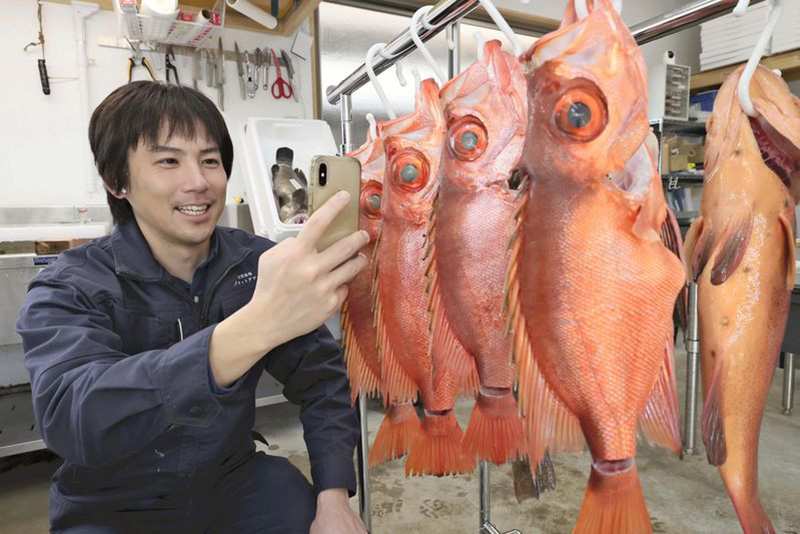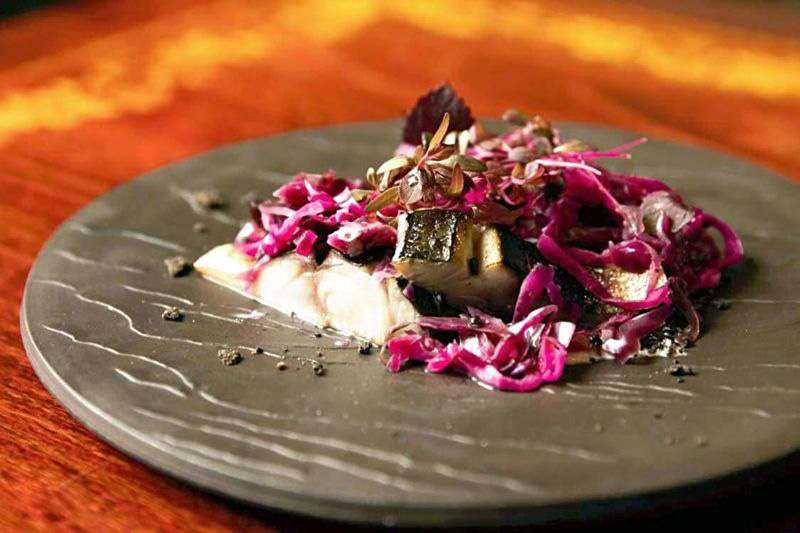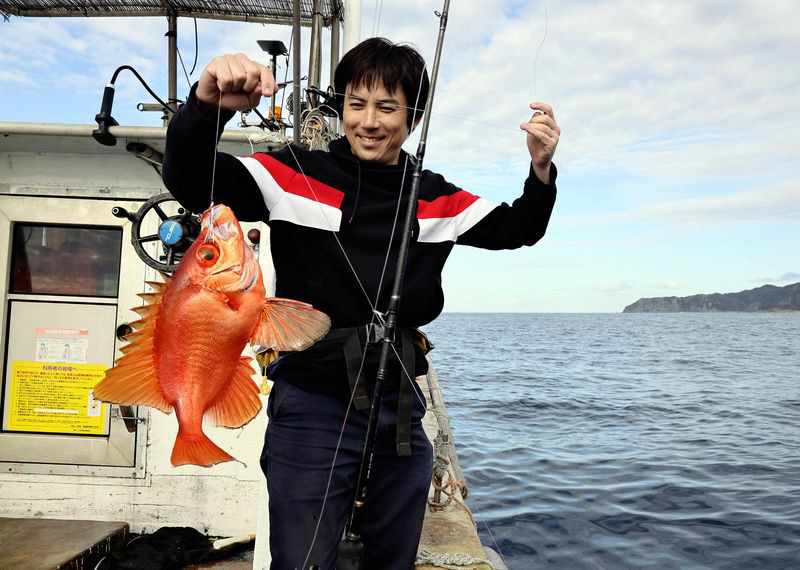
Kei Zenimoto uses his smartphone to promote the longfin bulleye in Tsushima, Nagasaki Prefecture, in December.
12:17 JST, February 22, 2022
TSUSHIMA, Nagasaki — Kei Zenimoto works as a single-line fisher in Tsushima, an island city in Nagasaki Prefecture located between Kyushu and South Korea. After a great haul of fish one day last December, he used his smartphone to show what he had caught to a chef at a French restaurant in Tokyo, about 1,000 kilometers away.
“Today, I caught some nice hiramasa [yellowtail amberjack] weighing 5.7 kilograms, which is fairly good,” he said to the chef. “I also caught some chikame-kintoki [longfin bulleye] that look like they ate well.”
The deal was done just in two minutes. “Being able to directly talk to my customers makes my job go faster,” Zenimoto said.
He moved to Tsushima seven years ago with the hopes of helping people all over the nation better appreciate the fish caught off the remote island. Fish there live in the Tsushima Current, a warm branch of the Kuroshio current.

A dish featuring the mackerel Zenimoto caught is served at the Alma Italian restaurant in Shibuya Ward, Tokyo.
Zenimoto used to study fish and sea currents at the University of Tokyo and Nagasaki University. He loved his studies but felt frustrated because he was too busy writing papers to have time for direct contact with fish.
He had become a researcher just because he loves fish. As a child in Hyogo Prefecture, Zenimoto used to catch fish in the Seto Inland Sea and cut them into pieces to offer to his neighbors.
As he reminisced about his younger days, an idea had come to him: “It’d be nice to work near the sea.”
Zenimoto inspected remote islands in Kyushu and elsewhere before eventually picking Tsushima. In 2016, he invited one of his younger fellow researchers to establish a company that covers everything from fishing to sales.

Zenimoto while fishing
The company turned to social media to promote his fish, as a way to overcome how remote their location is. A fish is drained of blood on the boat as soon as it is caught, with the spinal cord destroyed to preserve freshness. Images of such work are quickly uploaded on the company’s social media accounts. The company ships the fish on the day orders are placed, thus allowing customers to get the fish a half-day or one day earlier than they would if the fish were traded on the market.
In the first year, Zenimoto found it difficult to find customers for the company, with annual sales standing at just about ¥2 million. He made around ¥100,000 in after-tax monthly income at that time.
His business finally got on track in the spring of 2020, but then the pandemic caused orders from dining establishments — which generated almost all sales for his company — to fall to almost zero.
Despite the hardships, Zenimoto remained positive as he believed in the philosophy of making fishing a sustainable business. Fishers can earn more money if they catch fish using rods without overfishing and sell their catch directly to customers without brokers, he said. Their fish can also be more appreciated if each piece is carefully processed one by one.
Zenimoto is aware that this is just one small challenge, but he hopes he can help change the nation’s fishing industry as the industry has been decaying amid declining marine resources. His business venture made him feel more hopeful than impatient or anxious.
Amid the pandemic, Zenimoto’s company has focused more on regular customers than business operators, offering such additional services as cutting a whole fish into three pieces to make it easier to cook. He has also received requests to conduct lectures, which have given him the opportunity to promote his philosophy online.
Currently, Zenimoto’s company has about 50 individuals and restaurants as its clients, including some dining establishments that have been featured in the Michelin Guide. The company now earns sales of as much as about ¥3 million a month.
Masamitsu Sato, a chef at the Alma Italian restaurant in Shibuya Ward, Tokyo, has been placing orders with Zenimoto’s company for the past four years.
“The fish has a rich umami flavor because it was carefully processed. It’s an indispensable ingredient for our menu items,” the 33-year-old chef said. “I also concur with [Zenimoto’s] philosophy about fishing.”
With more clients, Zenimoto has received more requests for guided tours of Tsushima. More and more people have become interested in finding what environment the fish used to live in and how it was caught, he said.
Whenever he gets such requests, Zenimoto feels more than happy to take the time to show his customers around his fishing spots. The more they learn about the story of how the fish is delivered all the way to their homes, the closer they can feel to the waters off Tsushima, he believes.
"Business" POPULAR ARTICLE
-

Tokyo Economic Security Forum to Hold Inaugural Meeting Amid Tense Global Environment
-

Keidanren Chairman Yoshinobu Tsutsui Visits Kashiwazaki-Kariwa Nuclear Power Plant; Inspects New Emergency Safety System
-

Imports of Rare Earths from China Facing Delays, May Be Caused by Deterioration of Japan-China Relations
-

University of Tokyo Professor Discusses Japanese Economic Security in Interview Ahead of Forum
-

Japan Pulls out of Vietnam Nuclear Project, Complicating Hanoi’s Power Plans
JN ACCESS RANKING
-

Tokyo Economic Security Forum to Hold Inaugural Meeting Amid Tense Global Environment
-

Keidanren Chairman Yoshinobu Tsutsui Visits Kashiwazaki-Kariwa Nuclear Power Plant; Inspects New Emergency Safety System
-

Imports of Rare Earths from China Facing Delays, May Be Caused by Deterioration of Japan-China Relations
-

University of Tokyo Professor Discusses Japanese Economic Security in Interview Ahead of Forum
-

Japan Pulls out of Vietnam Nuclear Project, Complicating Hanoi’s Power Plans

























